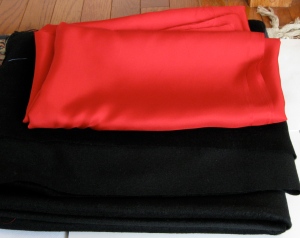First of all, thank you so much for the many wonderful comments on my coat. You made my week.
Now it’s time for me to give back to you and share some of the techniques. Let’s start with how to sew a fur collar, and next I’ll do a post on pad-stitching. It had been a few years (like 30) since I made a fur collar which required me to do a little research and to think through the process.
Starting with the end:
The fur – a piece of dyed lambswool approximately 24 x 24″.

Fur Alert!
The following steps resulted in small green fibers of fur in every corner of our house. You’d have thought I had a fluffy shedding pet who followed me around the house. Ugh!
Tutorial:
1. Select the piece of the fur from which you wish to cut the collar. All fur is not created equal – some parts of the pelt were clearly not usable as the fur was sparse or just didn’t look good, and I hoped to have enough left for cuffs.
2. When planning for the collar, if the pattern doesn’t have an upper collar piece which is larger than the under collar, increase the length and the width of the upper collar by approximately 1/2″. You will need this additional fabric so the collar turns well and to keep the fur visible and the under collar not visible.
3. Using a pointed scissors, cut the collar from the back side of the fur, only cutting through the pelt or fur backing. The fur fibers will separate without the help of a scissors.
4. As you plan to sew the upper and the under collar, for the width of the seam allowance, cut away the fur from the pelt or backing. Note: Do not cut away the actual seam allowance. This step reduces bulk when sewing the upper to the under collar.

5. Pin the upper and under collar together. Baste if you are so inclined. For leather you will need to pin in the seam allowance.
6. Sew the upper and under collar per the pattern instructions.
7. Before you trim the seam, turn the collar right side out. Use a pin or needle and pick out the fur fibers that got caught in the seam. If you don’t take this step, your collar will look like this:
8. Trim the seam in the same way as if you are working with fabric only
9. Now turn the collar and press. This was quite challenging for me as I didn’t want to burn the delicate lambswool. Good thing is that it didn’t need much pressing.

Now continue with your coat or garment construction.
























